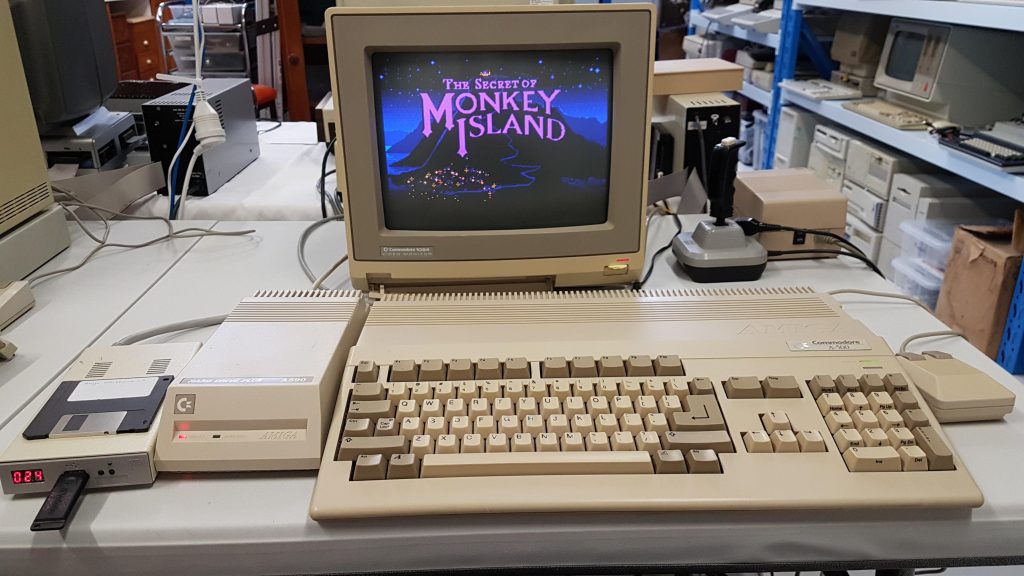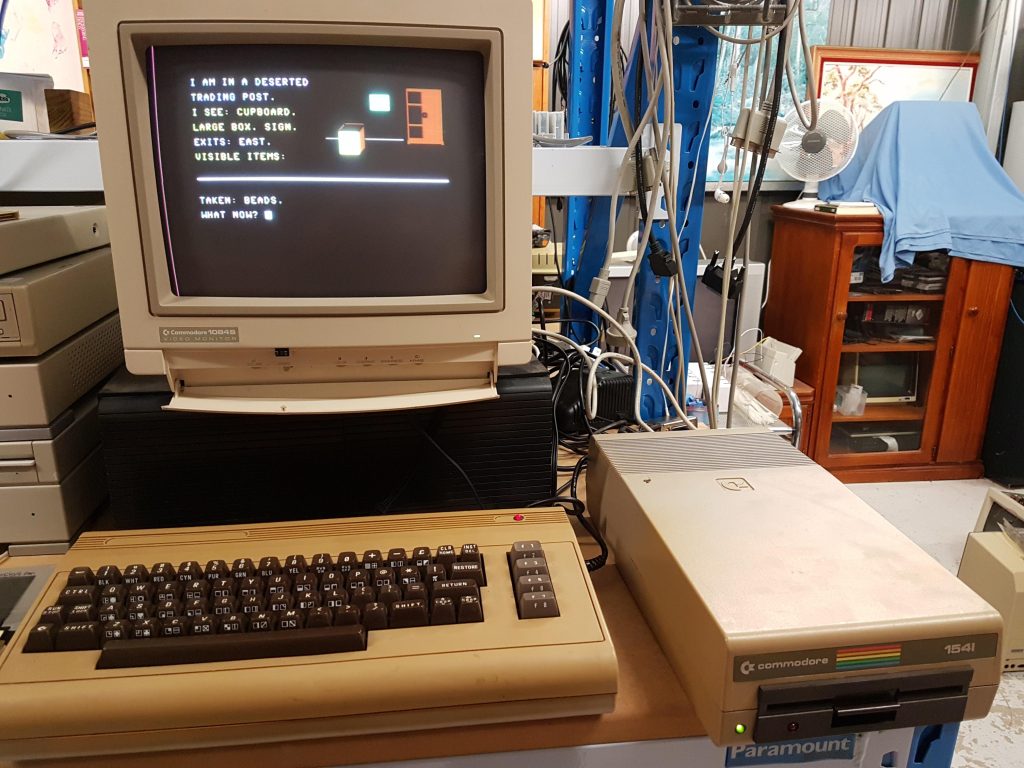I powered up with sockets empty and checked voltages. All good.
I added socketed devices. Three legs fell off one 6520 so that had an impact – particularly on the keyboard. I replaced the 6502 which had a weak leg and one 6520 which had lost three legs.
On power up there was a chirp which suggested some life.

I added the monitor and was relieved to get a picture, although clearly it hadn’t booted.
I tried the card from the first unit (also with a replacement 6502 for the same reason). It was less successful – no chirp and no picture, so it wasn’t getting as far. For now, I’ll stick with Board 2 – at least the ROMs have checked out.
My joy at the monitor working was short-lived, as it stopped working within 30 minutes. It produced quite horrible squiggly lines on the screen. I was unable to find any posts that described the effect and therefore the cure, so I checked the board over as best I could. All the transistors looked ok. The yoke coils seemed to be good. The flyback seemed ok. The usual suspect resistors were ok.
I was looking for a video that showed testing of the board without CRT connection, and in the process found a repair that involved diode D754 and the adjacent capacitor C754.
I found diode D754 was a 10 ohm resistor, and when I checked D253 one leg fell off. The faults may be related, or maybe not. I replaced the original VO6E diodes with 1N4004, which have the same voltage rating and slightly better recovery. I checked the capacitor and it seemed ok. I see a recap in this monitor’s future, though.
Following the replacement, the monitor was back working. I turned it all off and called it a night. It worked for a while the following day, but D754 then became a 2 ohm resistor. This time I replaced it with a diode with a higher reverse voltage limit 1N4007 (1kV rather than 400V) and I also replaced the C754. I had a 400V cap rather than the original 250V. I checked the voltage at the diode. It seems ok.
Back to the original problem …
I made up a PETTEST rom using a 2732 EPROM. This requires an adapter because the pinout does not quite match the ROM pinout. Three pins cut (from a socket): 18,20,and 21, and two wires added: pin 20 of the ROM socket to pin 18 of the 2732, and pin 18 of the ROM socket to pin 20 of the 2732.
I put it in the Edit Rom socket. It didn’t work at all so I read the instructions and in this post: https://forum.vcfed.org/index.php?threads/pet-4032-blank-screen.1239174/:
Look at the part number your PET EDIT ROM.
Then look at this website http://www.6502.org/users/andre/petindex/crtc.html and scroll to the bottom. You will find a spreadsheet called PET_CRTC.xls. Open this up and you will (hopefully) find a match for your EDIT ROM.
Use the values from the spreadsheet.
The CRTC registers are numbered from 0 through 17 (decimal) – a total of 18 numbers. The numbers in the spreadsheet are already in hexadecimal.
The CRTC initialisation table starts at byte offset 5 in my PETTESTER EPROM image. Hand-edit the 18 bytes using your EPROM programmer tools and burn the EPROM.
By adjusting the parameters you can set the PETTESTER to initialise the CRTC for 40/80 columns, 50/60 Hz frame refresh rate and for the number of raster lines per character displayed.
Just one problem – I don’t have the part number for the edit ROM because it’s an EPROM and the label was illegible. I do have an oscilloscope though, so I measured the vertical and horizontal scan frequencies – 50Hz and 20kHz respectively.
That makes it look like the last 6 lines in the spreadsheet, but I have not been able to match my edit ROM with any of the candidates. Tricky. This may take some experimenting. I started with the first one, and it worked – well, the video worked – but the video ram test failed. Using the scope, I could see it looping the video ram.
Several video RAM chips seemed not to be working – again, using the scope I could see variation between bits written and bits read.
Two 74LS244s also seemed to be bad because the input didn’t match the output for reads and/or writes. I replaced the ICs using sockets. They are FCT parts for now. The board is not easy to work with – difficult to remove solder from holes.
What I did notice was that having replaced the socketed video rams (two are unsocketed) and the 74LS244s, I was able to get every second character of the sign-on message using the normal edit ROM.

I replaced all the VRAM including the sockets and this resolved the missing characters.

But, I still didn’t have a cursor. Also, the pettest still didn’t seem to operate as expected – I never resolved this.
I tried swapping over the other PIA and the VIA with spare parts but no joy. The first PIA had already been swapped over due to corroding pins. A general poke around showed that a lot was going on, but I eventually found some indeterminate outputs on the bottom PIA and this turned out to be a poor connection at pin 1 VSS. I bent the pin in to put a bit more pressure on the single wipe contact and joy was had.
The full 32k of ram seems to be detected. There is one socketed chip in each RAM bank. Pulling the chip from the first bank causes the machine to not start. Pulling the chip from the second bank causes only 16k to be reported. Presumably there is at least a simple RAM test that has determined that all the RAM is OK.

At this point I wished that I had a working keyboard, but I had been putting them off because of the tedium involved in painting the contacts. Instead, I put a little piece of foil on a cotton bud and used it as a stylus.

This is positive, but the IEEE-488 drivers need to be replaced and the remaining single wipe sockets could easily cause problems in the future.

This gave me the necessary motivation to finish the keyboards. Which now work well.











































